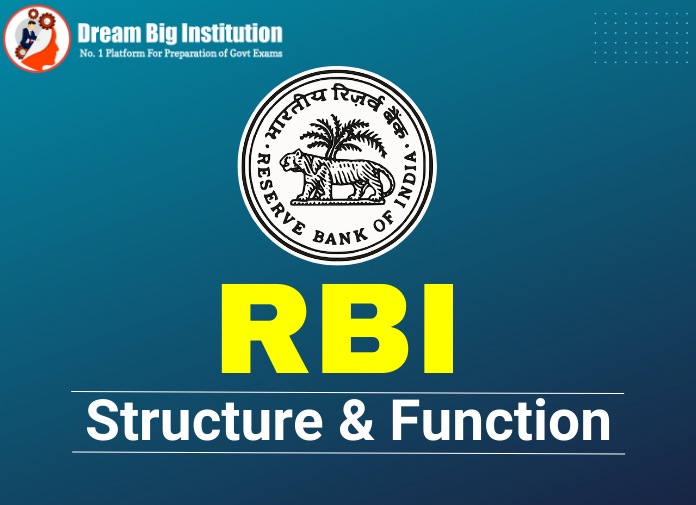RBI Structure and Functions: Reserve Bank of India is the central bank of India and in this article, we will be discussing the Structure and Functions of RBI. The topic is important for various banking exams like IBPS PO, IBPS Clerk, NABARD, RBI Grade B, SBI, SBI PO, SBI CBO, JAIIB, CAIIB but also important for other Government recruitment exams like SSC, UPSC, etc.
Table of Contents
RBI Structure and Functions:
Reserve Bank of India (RBI):
The central bank of India, known as the Reserve Bank of India (RBI), has a history that dates back to 1935 when it was established under the RBI Act of 1934. This was done based on the recommendations made by the John Hilton Young Commission in 1926, which was also referred to as the Royal Commission on Indian Currency and Finance. The RBI was initially headquartered in Calcutta, but in 1937, it was permanently moved to Mumbai. The bank was nationalized on January 1, 1949, and has since been fully owned by the Government of India.
Functions of RBI:
The Reserve Bank of India (RBI) has a variety of functions that contribute to its role as the central bank of the country. These functions include:
- Currency Issuance: The RBI is the sole authority in India responsible for issuing currency notes, which are signed by the Governor of the RBI. The bank distributes currency throughout the country with the help of currency chests.
- Banker to the Government: The RBI is often referred to as the “banker to the government” because it provides loans and other monetary assistance to the government through ways and means advances.
- Bankers’ Bank: The RBI serves as a lender of last resort, providing financial assistance to other banks whenever necessary through monetary instruments like export credit refinance, Liquidity Adjustment Facility, and Marginal Standing Facility.
- Controller of Banks: The RBI controls and regulates other banks based on established guidelines. It issues directives, conducts inspections (both on-site and off-site), and exercises management control.
- Controller of Credit: The RBI maintains liquidity in the market by setting interest rates (including the Bank Rate) and implementing selective credit controls. Tools like changes in cash reserve ratio, stipulations on securities margins, and directed credit guidelines are used for this purpose.
- Maintenance of External Value: The RBI is responsible for maintaining both the external and internal value of Indian currency. It holds foreign exchange reserves and has wide-ranging powers to regulate foreign exchange transactions under the Foreign Exchange Management Act.
Structure of RBI
Central Board
The Reserve Bank of India (RBI) is governed by a central board of directors, which serves as the highest governing body within its organizational structure. Additionally, there are four Local Boards responsible for addressing regional concerns, specifically for the Northern, Southern, Eastern, and Western areas of the country. The appointments/nominations of directors to the Central Board and members to the Local Boards are made by the central government, in accordance with the guidelines set out in the RBI Act. The composition of the Central Board is defined under Section 8(1) of the RBI Act, 1934.
The Central Board consists of:
- The Governor
- 4 Deputy Governors of the Reserve Bank
- 4 Directors nominated by the central government, one from each of the four Local Boards as constituted under Section 9 of the Act
- 10 Directors nominated by the central government
- 2 government officials nominated by the central government
The Central Board is assisted by three committees:
1.The Committee of the Central Board (CCB)
2.The Board for Financial Supervision (BFS)
3.The Board for Regulation and Supervision of Payment and Settlement Systems (BPSS)
Important facts related to RBI:
- The Reserve Bank of India (RBI) has several important facts associated with it:
- The RBI does not accept deposits from the general public.
- The prime lending rate of individual banks is not decided by the RBI.
- The RBI decides the bank rate, repo rate, reverse repo rate, and cash reserve ratio.
- The quantitative instruments of the RBI include the bank rate policy, cash reserve ratio, and statutory liquidity ratio.
- The objective of the monetary policy set by the RBI is to control inflation, discourage hoarding of commodities, and encourage the flow of credit to neglected sectors.
- The RBI serves as a lender of last resort, advancing credit against eligible securities.
- The Government of India decides the quantity of coins to be minted.
- The minimum reserve system is used in India for issuing currency notes. The RBI is required to hold a minimum reserve of Rs. 200 crores, of which no less than Rs. 115 crores is to be held in gold.
- The emblem of the RBI features a panther and a palm tree.
- Chintaman Dwarkanath Deshmukh was the first Indian governor of the RBI at the time of nationalization in 1949.
- K.J. Udeshi was the first woman Deputy Governor of the RBI.
Sample Questions: Structure and Functions of RBI
Q. What is the full form of RBI?
a. Reserve Bank of India
b. Reserve Board of India
c. Regulating Bank of India
d. Regulatory Board of India
Ans: a
Q. Which of the following is not a function of RBI?
a. Issuing currency notes
b. Regulating and supervising banks
c. Conducting monetary policy
d. Implementing foreign trade policy
Ans: d
Q. Which of the following is the highest decision-making body of RBI?
a. Board of Directors
b. Monetary Policy Committee
c. Executive Committee
d. Audit Committee
Ans: a
Q. What is the current repo rate set by RBI?
a. 4.25%
b. 5.25%
c. 6.25%
d. 7.25%
Ans: b
Q. Which department of RBI is responsible for regulating and supervising banks in India?
a. Department of Economic and Policy Research
b. Department of Banking Regulation
c. Department of Currency Management
d. Department of Supervision
Ans: d
Q. Which of the following is not a type of bank regulated by RBI?
a. Scheduled commercial banks
b. Non-scheduled commercial banks
c. Cooperative banks
d. Regional rural banks
Ans: b
Q. What is the current Cash Reserve Ratio (CRR) set by RBI?
a. 2%
b. 3%
c. 4%
d. 5%
Ans: d
Q. Which of the following is a tool used by RBI to manage liquidity in the banking system?
a. Cash Reserve Ratio
b. Statutory Liquidity Ratio
c. Repo Rate
d. All of the above
Ans: d
Q. What is the primary objective of RBI’s monetary policy?
a. Price stability
b. Economic growth
c. Employment generation
d. Poverty alleviation
Ans: a
Q. Which of the following is not a function of RBI’s Department of Currency Management?
a. Printing and distributing currency notes
b. Maintaining foreign exchange reserves
c. Coinage of currency
d. Managing the circulation of currency notes
Ans: b
FAQ on RBI Structure and Functions
Q. What is the structure and function of a bank?
Ans: Banks provide financial products and services to their clients in exchange for earning interest and fees. Banking executives must possess knowledge of complex monetary instruments in order to make sound decisions based on capital adequacy, asset management and interest rate risks.
Q. When was the Reserve Bank of India nationalized?
Ans: On the 1st of January, 1949, the RBI was nationalised by the Government of India. It then started functioning as the central bank of India.
Thank You for Reading this RBI Structure and Functions Article.
That is all from us in this blog. Hope you find the RBI Structure and Functions information is useful.
Happy Learning and Keep Sharing!
Download the DreamBigInstitution Mobile App for free study material and other latest updates.













